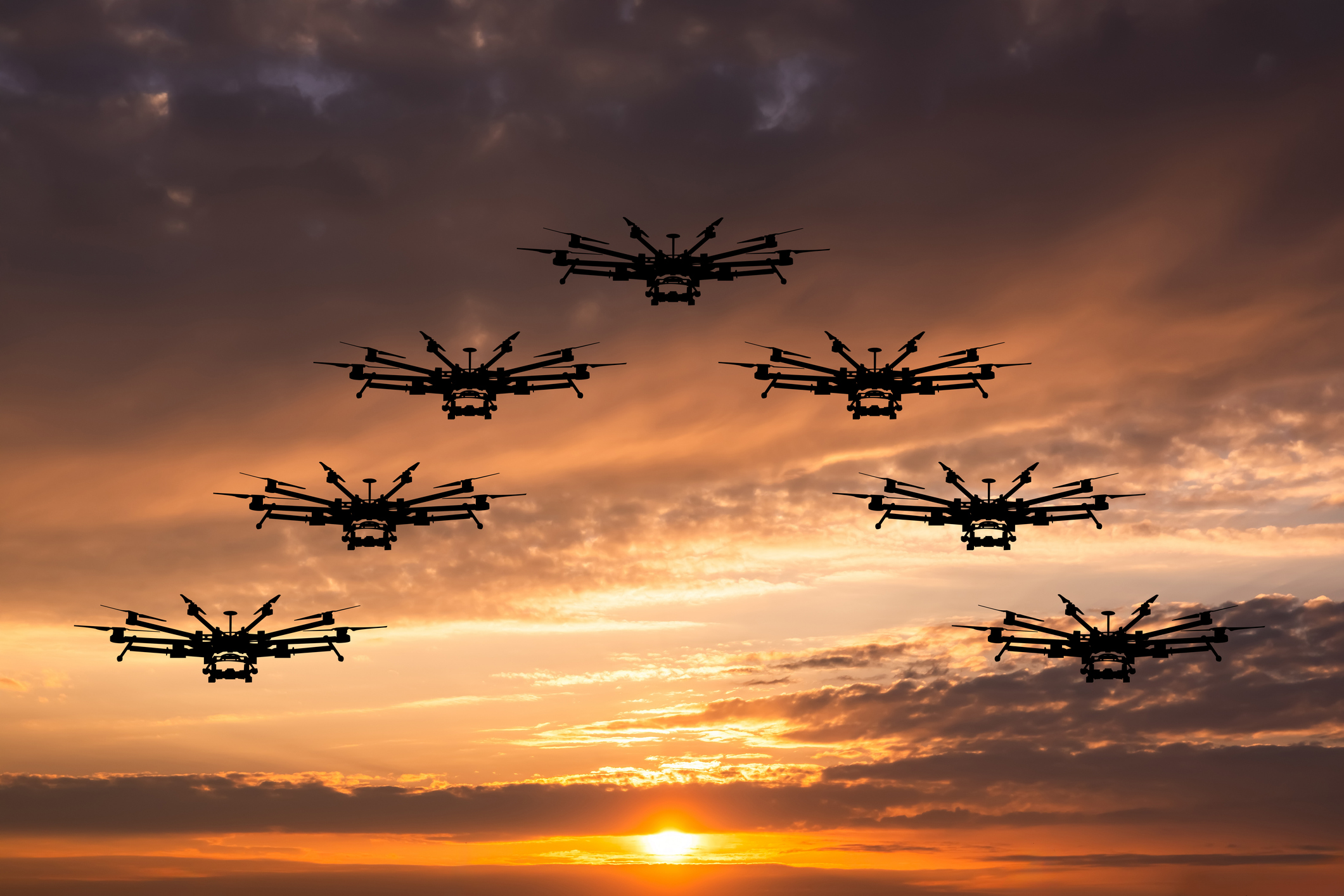By Dan McEvoy
Copyright moneyweek

Try 6 issues free
View all Investing
Stocks and Shares
Commodities
Personal Finance
Personal Finance
Personal Finance
Personal Finance
View all Personal Finance
Bank accounts
Credit cards
View all Economy
Global Economy
MoneyWeek quizzes
Spending it
On this day in history
Latest magazine issue
MoneyWeek glossary
Newsletters
Newsletter sign-up
Manage my newsletters
Latest newsletter
Newsletter sign up
Avoid pension pitfalls
MoneyWeek quiz
Energy bill changes
European defence funds
The rise of the drones
Unmanned aerial systems, or drones, are regarded as central to modern and future warfare, and soaring defence spending is set to double demand.
Newsletter sign up
When you purchase through links on our site, we may earn an affiliate commission. Here’s how it works.
(Image credit: Anton Petrus via Getty Images)
Dan McEvoy
25 September 2025
in Features
There were many eye-catching elements in China’s Victory Day Parade in Beijing on 3 September, not least the sight of Russian president Vladimir Putin and North Korea’s Kim Jong-un flanking Xi Jinping as the Chinese premier showcased his country’s military might, including a futuristic arsenal of laser weapons, nuclear missiles and some of the latest advances in drone and defence technology.
These technologies covered land, air and sea: “robotic wolves” – four-legged robots that can provide reconnaissance, carry ammunition and even launch precision strikes; AI-powered aerial drones that can fly alongside manned fighter jets; and perhaps most impressively the AJX-002, a 60-foot, unmanned submarine that can operate up to 20 metres underwater.
Drone technology is changing the face of warfare and accelerating a large shift in military doctrine, says Noah Ramos, a strategist at Alpine Macro. Drones that operate on land, sea and air are increasingly capable of interacting and collaborating with other drones, as well as with their human operators. This is shifting the balance of power within conflicts. Ukraine’s survival against all the odds following Russia’s invasion in February 2022 has been, in large part, thanks to its harnessing of drone technology. Its military, seemingly hopelessly undermanned and under-financed compared with Russia’s, has managed largely to neutralise Russia’s sophisticated (and expensive) war machines with a massive fleet of relatively inexpensive drones, two-fifths of which are made in Ukraine. Oleksandr Kamyshin, president Volodymyr Zelensky’s adviser for strategic affairs, told Bloomberg in July that weapons production is “Ukraine’s oil” and that the country is “rethinking warfare”.
Subscribe to MoneyWeek today and get your first six magazine issues absolutely FREE
Get 6 issues free
Sign up to Money Morning
Don’t miss the latest investment and personal finances news, market analysis, plus money-saving tips with our free twice-daily newsletter
Don’t miss the latest investment and personal finances news, market analysis, plus money-saving tips with our free twice-daily newsletter
What we have seen in the Ukraine war is that air defence can only work at scale if there is “drone parity”, Loredana Muharremi, aerospace and defence equity analyst at Morningstar, told MoneyWeek. Ukraine shows that “drone innovation is fast, cheap, but also decisive in overpowering more traditional, complex, expensive and slow systems”. The goal of drone manufacturers is not necessarily to create the “best” drone, but the most adaptable and cost-effective. The goal is to innovate quickly, produce cheaply and deploy quickly, she says. Companies that can do that “can enjoy, we believe, lasting competitive advantages”.
Trends in drone technology
On the same day that Xi Jinping flexed China’s military muscles before the eyes of the world, Peter Fortune, the MP for Bromley and Biggin Hill, told a House of Commons debate on the role of drones in warfare that “a $300,000 sea drone can destroy fighter jets worth $50bn”. Alistair Carns, the minister for the armed forces, told the same debate that countries such as Russia and China are already producing drones on an industrial scale and investing in innovation to make them more capable and deadly, and to remove the human presence even further from the battlefield. “War,” he said, “is driving an innovation cycle that cannot be replicated in peacetime.”
Carns has previously described recent advances in drone technology as “a machine-gun moment for the army, a submarine moment for the navy and a jet-engine moment for the air force”. But drones are not as new as one might imagine. Unmanned aerial vehicles were tested for training purposes by the British military during the World War I and the UK produced a number of unmanned aircraft in the 1930s.
One of these, the DH.82B Queen Bee, is thought to have inspired the term “drone”. Reconnaissance drones were also widely deployed during the Vietnam War and they have been used in various military contexts since, including acting as decoys, dropping leaflets and as weapons. Carns made the point to Parliament that drones can use thermal imaging to locate casualties who are hidden in rubble, smoke or woodland, and can deliver medical supplies to inaccessible areas, sheltering human medics from danger in doing so.
There are, in short, drones for just about everything on the battlefield these days. They can provide a mass of platforms that confuse the defence systems of the enemy, says Muharremi, and are cheap and hence expendable. They can overwhelm enemy radars and electronic warfare defences.
From the pages of science fiction
At the other end of the spectrum, some advanced drone variants are seemingly taken straight from the pages of science fiction. As impressive as China’s Victory Day display was, the country is largely playing catch-up to the US, which remains the world’s leader in drone technology. The Manta Ray, produced by the from US Defence Advanced Research Projects Agency (Darpa) and Northrop Grumman, is a case in point: it is a long-distance underwater drone that can harvest energy from ocean thermal gradients, as well as putting itself into a low-energy “hibernation” mode if required.
“Think of this as essentially a surveillance vehicle that has no range limitations and is equipped with an entire suite of incredibly high-tech sensors,” says Ramos. Also, because it doesn’t emit “heat signatures”, its very hard for enemy systems to detect.
In many respects, the latest trends in drone technology mirror developments that are playing out in the civilian realm. Questions of automation, computer vision and energy storage are as central to modern drone design as they are to the self-driving car contest between Tesla and Alphabet’s Waymo. Modern drones, explains Ramos, will often have light detection and ranging (LiDAR) sensors stacked on top of hyperspectral sensors, giving them a 3D vision of where they’re going, making them more effective in “contested environments”.
Modern drones also make use of multiple power sources to minimise the risk of a single point of failure. This could take the form of a conventional fossil-fuel-based power source alongside a battery. “If one part goes down or is disabled electronically, through jamming, the system on board can continue to operate,” explains Ramos.
But artificial intelligence and automation are the most significant drivers of technological advancement. Drones have always been “unmanned”, but for most of their history this has meant that they are controlled remotely by a human operator. Just as civilian vehicles are becoming capable of driving themselves, military drones are increasingly autonomous. The autonomous unmanned aerial vehicle (UAV) is the “next generation” drone, says Ramos. “Swarms” of drones can already be operated by a single human operator as remote sensors automatically optimise the space between and the distribution of the drones members and adjust if, for example, some of the other drones within the swarm are destroyed.
Unlocking defence spending
Rapidly accelerating innovation in drone technology is converging with another key tailwind for the sector: increased defence spending by governments the world over. In Europe, in particular, the war in Ukraine and US president Donald Trump’s insistence that the continent contributes more towards its own defence, have concentrated minds and unlocked billions of euros in fresh spending commitments.
Similar dynamics are playing out in other regions, too. Following China’s military parade, exchange-traded fund platform HANetf analysed projected defence spending throughout the Indo-Pacific region. It estimated that there will be about $600bn in additional defence spending by 2030, with $44bn of this coming from mature economies such as Japan, South Korea, Australia, Singapore and Taiwan, and $144bn from fast-growing economies such as India, Indonesia and the Philippines. Last year, analysis from GlobalX, another ETF platform, predicted that global military spending on drones will have doubled to approximately $45.2bn by 2030.
“There is something of a race going on for these future defence technologies and that’s going to create a lot of spending across the board,” says Jane Edmondson, head of index product strategy at VettaFi. VettaFi is an index provider that compiles, among others, the EQM Future of Defence index.
How to invest
There are ethical considerations to keep in mind before investing in drones, as with any branch of defence technology. Complex issues are raised, but investors may like at least to ensure that the companies they are investing in are aligned with Western values. The HANetf Future of Defence ETF (LSE:NATP) tracks VettaFi’s EQM Future of Defence index, and as such all holdings are screened for their alignment with Nato member states or allies. Similarly, the Global X Defence Tech ETF (LSE:ARMG) filters out companies based in China, India, Kuwait, Pakistan, Russia and Saudi Arabia (as well as any countries that are categorised neither as developed nor as an emerging market).
Funds like these will give investors exposure to many of the largest and more technologically innovative defence companies, which are typically the ones at the front line of drone innovation. Many of these larger companies, such as Leonardo (Milan: LDO), Thales (Paris: HO) and Rheinmetall (Frankfurt: RHM), have entered the drone sector through bolt-on acquisitions: “Speed is important right now, so buying the companies that already have the capability to build drones is the fastest way to get into the market” for these businesses, says Muharemmi.
This article was first published in MoneyWeek’s magazine. Enjoy exclusive early access to news, opinion and analysis from our team of financial experts with a MoneyWeek subscription.
Sign up for MoneyWeek’s newsletters
Get the latest financial news, insights and expert analysis from our award-winning MoneyWeek team, to help you understand what really matters when it comes to your finances.
Contact me with news and offers from other Future brandsReceive email from us on behalf of our trusted partners or sponsorsBy submitting your information you agree to the Terms & Conditions and Privacy Policy and are aged 16 or over.
Social Links Navigation
Senior Writer
Dan is a financial journalist who, prior to joining MoneyWeek, spent five years writing for OPTO, an investment magazine focused on growth and technology stocks, ETFs and thematic investing.
Before becoming a writer, Dan spent six years working in talent acquisition in the tech sector, including for credit scoring start-up ClearScore where he first developed an interest in personal finance.
Dan studied Social Anthropology and Management at Sidney Sussex College and the Judge Business School, Cambridge University. Outside finance, he also enjoys travel writing, and has edited two published travel books.
Brits to buy crypto to fulfil life goals as the regulator looks to lift restrictions on ETNs
Investors are gearing up to pump crypto into their portfolios ahead of the regulatory rule change, which will come into play next week
How will AI impact the pharma industry?
Drug discovery has been one of the greatest promises for AI for over a decade
You might also like
Investors can tap into juicy yields in overlooked companies’ debt and equity
Ian “Franco” Francis, fund manager, Manulife CQS New City High Yield Fund tells MoneyWeek where he’d put his money
Domino’s Pizza Group: A global brand going cheap
The troubles at Domino’s Pizza Group look cyclical rather than structural, says Rupert Hargreaves
Three poor deals for trust investors
Small shareholders need protection in related-party deals, says Bruce Packard
The challenge with currency hedging
A weaker dollar will make currency hedges more appealing, but volatile rates may complicate the results
8 of the best properties for sale with orangeries
From a converted Victorian Catholic school with a chapel in Kingston Upon Thames to a 12-acre country estate with mature gardens and a lake in Nantwich, Cheshire, we look at some of the best properties for sale with orangeries
Should you invest in Hansa Investment Company?
William Salomon has finally brought the two trusts he controls together. Should investors buy in?
Is Britain heading for a big debt crisis?
Things are not yet as bad as some reports have claimed. But they sure aren’t rosy either, says Julian Jessop
Bitcoin ‘has become the reserve asset of the internet’
The cryptocurrency has established itself as the electronic version of gold, says ByteTree’s Charlie Morris
View More \25b8
Useful links
Subscribe to MoneyWeek
Get the MoneyWeek newsletter
Latest Issue
Financial glossary
MoneyWeek Wealth Summit
MoneyWeek Live Reports
Most Popular
MoneyWeek share tips
MoneyWeek savings stories
MoneyWeek tax stories
Contact Future’s experts
Terms and Conditions
Privacy Policy
Cookie Policy
Advertise with us
MoneyWeek is part of Future plc, an international media group and leading digital publisher. Visit our corporate site.
Future Publishing Limited Quay House, The Ambury,
BA1 1UA. All rights reserved. England and Wales company registration number 2008885.



